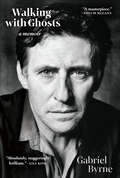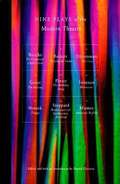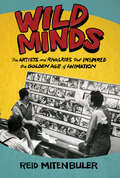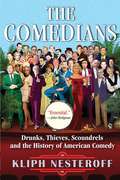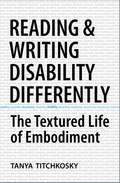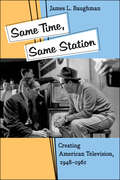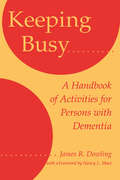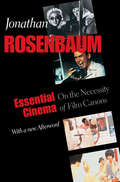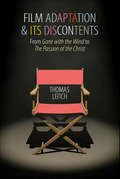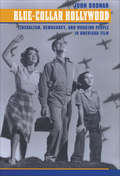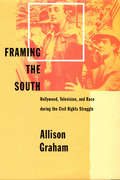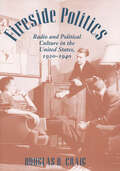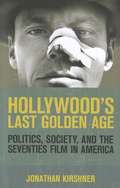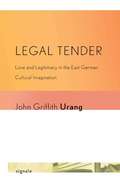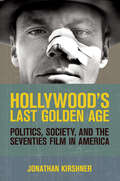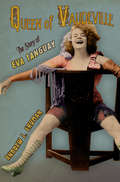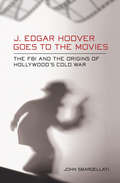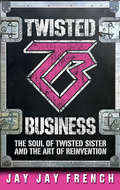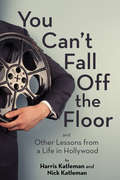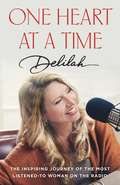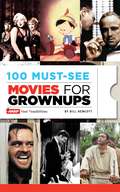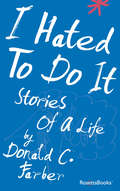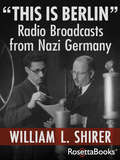- Table View
- List View
Walking with Ghosts: A Memoir
by Gabriel Byrne&“A gripping memoir&” by the Irish actor &“that is anything but typical Hollywood . . . evokes a beautiful sense of nostalgia, melancholy and vulnerability&” (Winnipeg Free Press). As a young boy growing up in the outskirts of Dublin, Gabriel Byrne sought refuge in a world of imagination among the fields and hills near his home, at the edge of a rapidly encroaching city. Born to working class parents and the eldest of six children, he harbored a childhood desire to become a priest. When he was eleven years old, Byrne found himself crossing the Irish Sea to join a seminary in England. Four years later, Byrne had been expelled and he quickly returned to his native city. There he took odd jobs as a messenger boy and factory laborer to get by. In his spare time, he visited the cinema, where he could be alone and yet part of a crowd. It was here that he could begin to imagine a life beyond the grey world of 1960s Ireland. In this memoir he revels in the theater and poetry of Dublin&’s streets, populated by characters as eccentric and remarkable as any in fiction, and recounts his decision to join an amateur theater group—a decision that would change his life forever. Moving between sensual recollection of childhood in a now almost vanished Ireland and reflections on stardom in Hollywood and on Broadway, Byrne also courageously recounts his battle with addiction and the ambivalence of fame. &“[Byrne] writes with much more depth than the typical celebrity memoirist, accessing some of Heaney&’s earthiness and Joyce&’s grasp of how Catholic guilt can shape an artist. . . . a winning dry humor that reads as authentically humble.&” —Kirkus Reviews (starred review) &“A masterpiece . . . by turns poetic, moving, and very funny. You will find it on the shelf alongside other great Irish memoirs including those by Frank McCourt, Nuala O&’Faolain and Edna O&’Brien.&” —Colum McCann &“A real writer, a born storyteller.&” —The Washington Post &“A dreamy book . . . He writes passionately about his first love and hilariously about his early fame as an actor.&” —Irish Times
Nine Plays Of The Modern Theater: The Caucasian Chalk Circle - Waiting For Godot - The Visit - The Balcony - The Birthday Party - Rhinoceros - Tango - Rosencrantz And Guildenstern Are Dead - American Buffalo
by Harold ClurmanVladimir, the more “philosophical” of the two vagrants in Beckett’s Waiting for Godot, stiffens their morale by asking, “. . . what’s the good of losing heart now? We should have thought of it a million years ago, in the nineties!” What does this mean in the play’s context? What were the nineties that these bewildered blighters should recall them with regret? It was perhaps a time when they had not yet entered upon their agony. It was a time of certainty, a beautiful time-or so it seemed to them and to most of their contemporaries.
Wild Minds: The Artists and Rivalries that Inspired the Golden Age of Animation
by Reid Mitenbuler“A thoroughly captivating behind-the-scenes history of classic American animation . . . A must-read for all fans of the medium.” —Matt GroeningIn 1911, famed cartoonist Winsor McCay debuted one of the first animated cartoons, based on his sophisticated newspaper strip “Little Nemo in Slumberland,” itself inspired by Freud’s recent research on dreams. McCay is largely forgotten today, but he unleashed an art form, and the creative energy of artists from Otto Messmer and Max Fleischer to Walt Disney and Warner Bros.’ Chuck Jones. Their origin stories, rivalries, and sheer genius, as Reid Mitenbuler skillfully relates, were as colorful and subversive as their creations—from Felix the Cat to Bugs Bunny to feature films such as Fantasia—which became an integral part and reflection of American culture over the next five decades.Pre-television, animated cartoons were aimed squarely at adults; comic preludes to movies, they were often “little hand grenades of social and political satire.” Early Betty Boop cartoons included nudity; Popeye stories contained sly references to the injustices of unchecked capitalism. During WWII, animation also played a significant role in propaganda. The Golden Age of animation ended with the advent of television, when cartoons were sanitized to appeal to children and help advertisers sell sugary breakfast cereals.Wild Minds is an ode to our colorful past and to the creative energy that later inspired The Simpsons, South Park, and BoJack Horseman.“A quintessentially American story of daring ambition, personal reinvention and the eternal tug-of-war of between art and business . . . a gem for anyone wanting to understand animation’s origin story.” —NPR
The Comedians: Drunks, Thieves, Scoundrels, And The History Of American Comedy
by Kliph NesteroffIn The Comedians, comedy historian Kliph Nesteroff brings to life a century of American comedy with real-life characters, forgotten stars, mainstream heroes and counterculture iconoclasts. Based on over two hundred original interviews and extensive archival research, Nesteroff's groundbreaking work is a narrative exploration of the way comedians have reflected, shaped, and changed American culture over the past one hundred years. <P><P> Starting with the vaudeville circuit at the turn of the last century, Nesteroff introduces the first stand-up comedian--an emcee who abandoned physical shtick for straight jokes. After the repeal of Prohibition, Mafia-run supper clubs replaced speakeasies, and mobsters replaced vaudeville impresarios as the comedian's primary employer. In the 1950s, the late-night talk show brought stand-up to a wide public, while Lenny Bruce, Mort Sahl, and Jonathan Winters attacked conformity and staged a comedy rebellion in coffeehouses. From comedy's part in the Civil Rights movement and the social upheaval of the late 1960s, to the first comedy clubs of the 1970s and the cocaine-fueled comedy boom of the 1980s,The Comedians culminates with a new era of media-driven celebrity in the twenty-first century.
Reading and Writing Disability Differently: The Textured Life of Embodiment
by Tanya TitchkoskyIn this study, Titchkosky analyzes the depiction of disabled people in the mass media. Through an examination of everyday texts such as news stories and government surveys, she uncovers and critiques a Western cultural assumption that sees disability as a clear-cut "problem" in need of a solution. Titchkosky (disability studies, U. of Toronto) is also the author of Disability, Self, and Society (2003). Annotation ©2007 Book News, Inc., Portland, OR (booknews.com)
Same Time, Same Station: Creating American Television, 1948–1961
by James L. BaughmanOutstanding Academic Title for 2007, Choice MagazineEver wonder how American television came to be the much-derided, advertising-heavy home to reality programming, formulaic situation comedies, hapless men, and buxom, scantily clad women? Could it have been something different, focusing instead on culture, theater, and performing arts?In Same Time, Same Station, historian James L. Baughman takes readers behind the scenes of early broadcasting, examining corporate machinations that determined the future of television. Split into two camps—those who thought TV could meet and possibly raise the expectations of wealthier, better-educated post-war consumers and those who believed success meant mimicking the products of movie houses and radio—decision makers fought a battle of ideas that peaked in the 1950s, just as TV became a central facet of daily life for most Americans.Baughman’s engagingly written account of the brief but contentious debate shows how the inner workings and outward actions of the major networks, advertisers, producers, writers, and entertainers ultimately made TV the primary forum for entertainment and information. The tale of television's founding years reveals a series of decisions that favored commercial success over cultural aspiration.
Keeping Busy: A Handbook of Activities for Persons with Dementia
by James R. DowlingAlthough very little can be done to alter the course of dementia, much can be done to maximize the quality of life of people with the condition. Research as well as practical experience suggest that behavior management, especially through programs that provide meaningful and constructive activity, is currently the most effective treatment.In Keeping Busy, James Dowling describes a variety of activities designed to bring meaning and enjoyment to the lives of persons with dementia. The activities are organized by general categories such as music, exercise, horticulture, pets, humor, and social events. The largest section deals with communication and includes word games that help people strengthen their remaining verbal skills. The description of each activity includes step-by-step instructions, as well as tips on how to adapt it for small or large groups, for individuals at home or in an organization, or people who are bedridden.
Essential Cinema: On the Necessity of Film Canons
by Jonathan RosenbaumIn his astute and deeply informed film reviews and essays, Jonathan Rosenbaum regularly provides new and brilliant insights into the cinema as art, entertainment, and commerce. Guided by a personal canon of great films, Rosenbaum sees, in the ongoing hostility toward the idea of a canon shared by many within the field of film studies, a missed opportunity both to shape the discussion about cinema and to help inform and guide casual and serious filmgoers alike.In Essential Cinema, Rosenbaum forcefully argues that canons of great films are more necessary than ever, given that film culture today is dominated by advertising executives, sixty-second film reviewers, and other players in the Hollywood publicity machine who champion mediocre films at the expense of genuinely imaginative and challenging works. He proposes specific definitions of excellence in film art through the creation a personal canon of both well-known and obscure movies from around the world and suggests ways in which other canons might be similarly constructed.Essential Cinema offers in-depth assessments of an astonishing range of films: established classics such as Rear Window, M, and Greed; ambitious but flawed works like The Thin Red Line and Breaking the Waves; eccentric masterpieces from around the world, including Irma Vep and Archangel; and recent films that have bitterly divided critics and viewers, among them Eyes Wide Shut and A.I. He also explores the careers of such diverse filmmakers as Robert Altman, Raúl Ruiz, Frank Tashlin, Elaine May, Sam Fuller, Terrence Davies, Edward Yang, Hou Hsiao-hsien, and Orson Welles. In conclusion, Rosenbaum offers his own film canon of 1,000 key works from the beginning of cinema to the present day. A cogent and provocative argument about the art of film, Essential Cinema is also a fiercely independent reference book of must-see movies for film lovers everywhere.
Film Adaptation and Its Discontents: From Gone with the Wind to The Passion of the Christ
by Thomas LeitchMost books on film adaptation—the relation between films and their literary sources—focus on a series of close one-to-one comparisons between specific films and canonical novels. This volume identifies and investigates a far wider array of problems posed by the process of adaptation. Beginning with an examination of why adaptation study has so often supported the institution of literature rather than fostering the practice of literacy, Thomas Leitch considers how the creators of short silent films attempted to give them the weight of literature, what sorts of fidelity are possible in an adaptation of sacred scripture, what it means for an adaptation to pose as an introduction to, rather than a transcription of, a literary classic, and why and how some films have sought impossibly close fidelity to their sources. After examining the surprisingly divergent fidelity claims made by three different kinds of canonical adaptations, Leitch's analysis moves beyond literary sources to consider why a small number of adapters have risen to the status of auteurs and how illustrated books, comic strips, video games, and true stories have been adapted to the screen. The range of films studied, from silent Shakespeare to Sherlock Holmes to The Lord of the Rings, is as broad as the problems that come under review.
Blue-Collar Hollywood: Liberalism, Democracy, and Working People in American Film
by John BodnarSelected by Choice Magazine as an Outstanding Academic Title for 2003From Tom Joad to Norma Rae to Spike Lee's Mookie in Do the Right Thing, Hollywood has regularly dramatized the lives and struggles of working people in America. Ranging from idealistic to hopeless, from sympathetic to condescending, these portrayals confronted audiences with the vital economic, social, and political issues of their times while providing a diversion—sometimes entertaining, sometimes provocative—from the realities of their own lives.In Blue-Collar Hollywood, John Bodnar examines the ways in which popular American films made between the 1930s and the 1980s depicted working-class characters, comparing these cinematic representations with the aspirations of ordinary Americans and the promises made to them by the country's political elites. Based on close and imaginative viewings of dozens of films from every genre—among them Public Enemy, Black Fury, Baby Face, The Grapes of Wrath, It's a Wonderful Life, I Married a Communist, A Streetcar Named Desire, Peyton Place, Taxi Driver, Raging Bull, Coal Miner's Daughter, and Boyz N the Hood—this book explores such topics as the role of censorship, attitudes toward labor unions and worker militancy, racism, the place of women in the workforce and society, communism and the Hollywood blacklist, and faith in liberal democracy.Whether made during the Great Depression, World War II, the Cold War, or the Vietnam era, the majority of films about ordinary working Americans, Bodnar finds, avoided endorsing specific political programs, radical economic reform, or overtly reactionary positions. Instead, these movies were infused with the same current of liberalism and popular notion of democracy that flow through the American imagination.
Framing the South: Hollywood, Television, and Race during the Civil Rights Struggle
by Allison GrahamWhat patterns emerge in media coverage and character depiction of Southern men and women, blacks and whites, in the years between 1954 and 1976? How do portrayals of the region and the equal rights movement illuminate the spirit and experience of the South—and of the nation as a whole? In Framing the South, Allison Graham examines the ways in which the media, particularly television and film, presented Southerners during the period of the civil rights revolution.Graham analyzes depictions of southern race and social class in a wide range of Hollywood films—including A Streetcar Named Desire, The Three Faces of Eve, and A Face in the Crowd from the 1950s; later films like Cool Hand Luke, In the Heat of the Night, and Mississippi Burning; and MGM's Elvis Presley vehicles. She traces how films have confronted—or avoided—issues of racism over the years, paralleling Hollywood depictions with the tamer characterization of the likeable "hillbilly" popularized in television's The Real McCoys and The Andy Griffith Show. Graham reinforces the political impact of these fictional representations by examining media coverage of civil rights demonstrations, including the documentary Crisis: Behind the Presidential Commitment, which reported the clash between Robert Kennedy and Governor George Wallace over the integration of the University of Alabama. She concludes with a provocative analysis of Forrest Gump, identifying the popular film as a retelling of post-World War II Southern history.
Fireside Politics: Radio and Political Culture in the United States, 1920–1940 (Reconfiguring American Political History)
by Douglas B. CraigAn “impressively researched and useful study” of the golden age of radio and its role in American democracy (Journal of American History).In Fireside Politics, Douglas B. Craig provides the first detailed and complete examination of radio’s changing role in American political culture between 1920 and 1940—the medium’s golden age, when it commanded huge national audiences without competition from television.Craig follows the evolution of radio into a commercialized, networked, and regulated industry, and ultimately into an essential tool for winning political campaigns and shaping American identity in the interwar period. Finally, he draws thoughtful comparisons of the American experience of radio broadcasting and political culture with those of Australia, Britain, and Canada.“The best general study yet published on the development of radio broadcasting during this crucial period when key institutional and social patterns were established.” ?Technology and Culture
Fireside Politics: Radio and Political Culture in the United States, 1920-1940 (Reconfiguring American Political History)
by Douglas B. CraigIn Fireside Politics, Douglas B. Craig provides the first detailed and complete examination of radio's changing role in American political culture between 1920 and 1940—the medium's golden age, when it commanded huge national audiences without competition from television. Craig follows the evolution of radio into a commercialized, networked, and regulated industry, and ultimately into an essential tool for winning political campaigns and shaping American identity in the interwar period. Finally, he draws thoughtful comparisons of the American experience of radio broadcasting and political culture with those of Australia, Britain, and Canada.
Hollywood's Last Golden Age
by Jonathan KirshnerBetween 1967 and 1976 a number of extraordinary factors converged to produce an uncommonly adventurous era in the history of American film. The end of censorship, the decline of the studio system, economic changes in the industry, and demographic shifts among audiences, filmmakers, and critics created an unprecedented opportunity for a new type of Hollywood movie, one that Jonathan Kirshner identifies as the "seventies film." In Hollywood's Last Golden Age, Kirshner shows the ways in which key films from this period-including Chinatown, Five Easy Pieces, The Graduate, and Nashville, as well as underappreciated films such as The Friends of Eddie Coyle, Klute, and Night Moves-were important works of art in continuous dialogue with the political, social, personal, and philosophical issues of their times. These "seventies films" reflected the era's social and political upheavals: the civil rights movement, the domestic consequences of the Vietnam war, the sexual revolution, women's liberation, the end of the long postwar economic boom, the Shakespearean saga of the Nixon Administration and Watergate. Hollywood films, in this brief, exceptional moment, embraced a new aesthetic and a new approach to storytelling, creating self-consciously gritty, character-driven explorations of moral and narrative ambiguity. Although the rise of the blockbuster in the second half of the 1970s largely ended Hollywood's embrace of more challenging films, Kirshner argues that seventies filmmakers showed that it was possible to combine commercial entertainment with serious explorations of politics, society, and characters' interior lives.
Legal Tender
by John Griffith UrangTreating films including Leander Hauss/mann's controversial Sonnenalle (1999), Urang (visiting professor of German, Reed College, Portland, Oregon) explores the question of why in so many East German films and novels love trumps the crumbling political culture of the GDR. Citing Niklas Luhmann's Love as Passion: The Codification of Intimacy as a key influence, he examines how the "semantics of love" interact with socialist-realist processes of authoritarianism. While these love stories draw on the Western tradition, they also critique bourgeois romantic love institutions and practices--a metaphor for reunification with West Germany. Annotation ©2011 Book News, Inc. , Portland, OR (booknews. com)
Hollywood's Last Golden Age: Politics, Society, and the Seventies Film in America
by Jonathan KirshnerBetween 1967 and 1976 a number of extraordinary factors converged to produce an uncommonly adventurous era in the history of American film. The end of censorship, the decline of the studio system, economic changes in the industry, and demographic shifts among audiences, filmmakers, and critics created an unprecedented opportunity for a new type of Hollywood movie, one that Jonathan Kirshner identifies as the "seventies film." In Hollywood's Last Golden Age, Kirshner shows the ways in which key films from this period-including Chinatown, Five Easy Pieces, The Graduate, and Nashville, as well as underappreciated films such as The Friends of Eddie Coyle, Klute, and Night Moves-were important works of art in continuous dialogue with the political, social, personal, and philosophical issues of their times.These "seventies films" reflected the era's social and political upheavals: the civil rights movement, the domestic consequences of the Vietnam war, the sexual revolution, women's liberation, the end of the long postwar economic boom, the Shakespearean saga of the Nixon Administration and Watergate. Hollywood films, in this brief, exceptional moment, embraced a new aesthetic and a new approach to storytelling, creating self-consciously gritty, character-driven explorations of moral and narrative ambiguity. Although the rise of the blockbuster in the second half of the 1970s largely ended Hollywood's embrace of more challenging films, Kirshner argues that seventies filmmakers showed that it was possible to combine commercial entertainment with serious explorations of politics, society, and characters' interior lives.
Queen of Vaudeville: The Story of Eva Tanguay
by Andrew ErdmanIn her day, Eva Tanguay (1879-1947) was one of the most famous women in America. Widely known as the "I Don't Care Girl"-named after a song she popularized and her independent, even brazen persona-Tanguay established herself as a vaudeville and musical comedy star in 1904 with the New York City premiere of the show My Lady-and never looked back. Tanguay was, at the height of a long career that stretched until the early 1930s, a trend-setting performer who embodied the emerging ideal of the bold and sexual female entertainer. Whether suggestively singing songs with titles like "It's All Been Done Before But Not the Way I Do It" and "Go As Far As You Like" or wearing a daring dress made of pennies, she was a precursor to subsequent generations of performers, from Mae West to Madonna and Lady Gaga, who have been both idolized and condemned for simultaneously displaying and playing with blatant displays of female sexuality.In Queen of Vaudeville, Andrew L. Erdman tells Eva Tanguay's remarkable life story with verve. Born into the family of a country doctor in rural Quebec and raised in a New England mill town, Tanguay found a home on the vaudeville stage. Erdman follows the course of her life as she amasses fame and wealth, marries (and divorces) twice, engages in affairs closely followed in the press, declares herself a Christian Scientist, becomes one of the first celebrities to get plastic surgery, loses her fortune following the Wall Street Crash of 1929, and receives her last notice, an obituary in Variety. The arc of Tanguay's career follows the history of American popular culture in the first half of the twentieth century. Tanguay's appeal, so dependent on her physical presence and personal charisma, did not come across in the new media of radio and motion pictures. With nineteen rare or previously unpublished images, Queen of Vaudeville is a dynamic portrait of a dazzling and unjustly forgotten show business star.
J. Edgar Hoover Goes to the Movies: The FBI and the Origins of Hollywood's Cold War
by John SbardellatiBetween 1942 and 1958, J. Edgar Hoover's Federal Bureau of Investigation conducted a sweeping and sustained investigation of the motion picture industry to expose Hollywood's alleged subversion of "the American Way" through its depiction of social problems, class differences, and alternative political ideologies. FBI informants (their names still redacted today) reported to Hoover's G-men on screenplays and screenings of such films as Frank Capra's It's a Wonderful Life (1946), noting that "this picture deliberately maligned the upper class attempting to show that people who had money were mean and despicable characters." The FBI's anxiety over this film was not unique; it extended to a wide range of popular and critical successes, including The Grapes of Wrath (1940), The Best Years of Our Lives (1946), Crossfire (1947) and On the Waterfront (1954). In J. Edgar Hoover Goes to the Movies, John Sbardellati provides a new consideration of Hollywood's history and the post-World War II Red Scare. In addition to governmental intrusion into the creative process, he details the efforts of left-wing filmmakers to use the medium to bring social problems to light and the campaigns of their colleagues on the political right, through such organizations as the Motion Picture Alliance for the Preservation of American Ideals, to prevent dissemination of "un-American" ideas and beliefs. Sbardellati argues that the attack on Hollywood drew its motivation from a sincerely held fear that film content endangered national security by fostering a culture that would be at best apathetic to the Cold War struggle, or, at its worst, conducive to communism at home. Those who took part in Hollywood's Cold War struggle, whether on the left or right, shared one common trait: a belief that the movies could serve as engines for social change. This strongly held assumption explains why the stakes were so high and, ultimately, why Hollywood became one of the most important ideological battlegrounds of the Cold War.
At the Piano with Fauré
by Marguerite LongThe virtuoso pianist and teacher, Marguerite Long, was a great friend of Fauré and the foremost interpreter of his music.
Twisted Business: The Soul of Twisted Sister and the Art of Reinvention
by Jay Jay FrenchThe founder, guitarist, and manager of the world-famous heavy metal band Twisted Sister—delivers his &“bizoir&”: part memoir and part business primer. In addition to founding Twisted Sister, a band that has sold more than 20 million records worldwide, Jay Jay French is one of the top entrepreneurs in entertainment. After taking over as manager in the &‘70s, French developed Twisted Sister into the most heavily licensed heavy metal band in history, leading the group to perform more than 9,000 shows in forty countries. Part business book, part memoir, Twisted Business is an unexpected, inspiring, whirlwind story of transformation and redemption. Twisted Business follows French&’s adventure-filled life—from growing up in New York City in the sixties, to working as a drug dealer and struggling as an addict before quitting cold-turkey, and finally, to creating and cultivating Twisted Sister and turning it into one of the most successful brands in the world. Together with his mentor, Steve Farber, a bestselling author and one of the world&’s top leadership and management experts, French offers unique, hard-earned tips and advice from his nearly 50 years as a musician, music business manager, and entrepreneur. French shows how, through tenacity, grit, and dedication, anyone can create their own brand, grow a successful business, re-invent themselves, or simply find success in what they love to do. Entertaining, provocative, funny, and informative, this book is the trip of a lifetime and a treasured guide for entrepreneurs, businesspeople, and music fans alike.
You Can't Fall Off the Floor: And Other Lessons from a Life in Hollywood
by Harris Katleman Nick KatlemanA studio executive&’s &“superb memoir&” of his years in the industry, filled with hilarious stories and hard-earned wisdom (Library Journal). From watching his colleague get shot in the testicles by a jealous producer to running Hollywood&’s most successful TV studio, Harris Katleman had a front row seat in the development of the television industry. A classic account of the business side of entertainment, this book shares what really happened in the early careers of Hollywood stars and the development of iconic programs. Through a number of funny behind-the-scenes anecdotes, Katleman shares his journey from office boy to talent agent to television producer, and finally to studio head at both MGM and Twentieth Century Fox. Along the way, we meet industry giants including Rupert Murdoch, Bob Iger, Barry Diller, Marvin Davis, Kirk Kerkorian, Mark Goodson, and Lew Wasserman. This memoir goes beyond the story of a life in Hollywood. It is the story of crucial developments—how motion picture film libraries were opened for television licensing, how The Simpsons was birthed, and much more. &“Not only does this book show his leadership in the television business, it shows how strongly he fought for groundbreaking shows that transformed the industry.&”—David E. Kelley &“A worthy entry in the lexicon of books chronicling Hollywood of yesteryear.&”—Booklist
One Heart at a Time
by Delilah“You’re listening to Delilah.”Delilah, the most listened to woman on American radio, has distinguished herself as the “Queen of Sappy Love Songs” and America’s ultimate romance guru. But Delilah’s life off-air is all the more extraordinary—a life full of trials, forgiveness, faith, and adventure. In One Heart at a Time, Delilah’s heartfelt account of her own story reveals what shaped the voice that 9 million listeners know and love.Today, Delilah is the founder of an NGO called Point Hope, the owner of a 55-acre working farm, and an inductee of the National Radio Hall of Fame. But to achieve this, she often had to pave her own way. Disowned by her father, divorced, and fired from a dozen jobs over the years, Delilah pushed forward through family addiction and devastating loss, through glass ceilings and red tape. Her consistent goal to help those in need took her everywhere from the streets of Philadelphia to refugee camps in Ghana.Along the way, Delilah was blessed by 13 children, 10 of them adopted. Though many of them contend with special needs and the forever effects of a broken foster care system, her children have been able to transform their own remarkable lessons into guiding lights for other kids in need. Just as Delilah has done.One Heart at a Time exposes the real woman behind the microphone. In her easy-going style and characteristic, beloved voice, Delilah tells her deeply moving life story as the series of miracles it is.A portion of proceeds will be donated to Point Hope.
100 Must-See Movies for Grownups
by Bill Newcott“Oh! What a wonderful list. Bill Newcott's top 100 makes you want to curl up with a stack of DVD’s and revisit Hollywood’s best.” — Arch Campbell, Broadcast Film Critics Association“...a treasure trove of sterling and often delightfully offbeat recommendations for discerning moviegoers, from the beginnings of film right up the present.” — Peter Rainer, author of Rainer on Film: Thirty Years of Film Writing in a Turbulent and Transformative EraFinally, an end to the old complaint, “There’s nothing to watch!” Since 2002, AARP’s Movies for Grownups has been celebrating movies with special appeal for the 50+ audience through reviews, film festivals, private screenings, and a weekly TV series. Now, in the first-ever Movies for Grownups book, MFG creator Bill Newcott selects the 100 essential films for those who love great cinema.The collection includes a variety of classics, from Gone with the Wind and Casablanca to new favorites like Capote and The King’s Speech. You’ll also find every film that has won the coveted trophy for the year’s Best Movie for Grownups, chosen by the editors of AARP the Magazine. Then there are the hidden gems—films you may never have heard of, but ones you’ll never forget once you see them, thanks to this comprehensive, concisely written collection.
I Hated To Do It: Stories of a Life
by Donald C. FarberA memoir by the legendary entertainment lawyer, &“an advisor/pal to so many stars of stage and screen that the dazzle will leave you blinking&” (Dan Wakefield, national-bestselling author). For more than forty years, Donald C. Farber forged a path through New York&’s literary, theatrical, and celebrity circles. As Kurt Vonnegut&’s attorney, literary agent, and close friend, he offers a rare portrait of Vonnegut that is both candid and entertaining. A renowned entertainment lawyer with a largely famous clientele and a highly acclaimed author in his own right, Farber provides colorful anecdotes that detail the daily realities of working with Vonnegut from the perspective of the person who knew him best. I Hated to Do It is also &“an amazing account of the one survivor of his company in WWII, a man who believed in an off-Broadway musical The Fantasticks (that is still paying off his investment), and his journey in theatrical law . . . Don is a great storyteller who keeps you always entranced&” (Dan Wakefield, national-bestselling author of Going All the Way).
"This Is Berlin": Radio Broadcasts from Nazi Germany
by William L. ShirerThe legendary CBS news journalist&’s selection of iconic World War II radio broadcasts from countries throughout Europe. William L. Shirer was the first journalist hired by CBS to cover World War II in Europe, where he continued to work for over a decade as a news broadcaster. This book compiles two and a half years&’ worth of wartime broadcasts from Shirer&’s time on the ground during WWII. He was with Nazi forces when Hitler invaded Austria and made it a part of Germany under the Anschluss; he was also the first to report back to the United States on the armistice between France and Nazi forces in June of 1940. His daily roundup of news from Paris, Vienna, Berlin, Rome, and London, which documented Nazi Germany and the conditions of countries under invasion and at war, became famous for its gripping urgency. Shirer brought a sense of immediacy to the war for listeners in the United States and worldwide, and his later books, including the seminal Rise and Fall of the Third Reich, became definitive works on World War II history. This collection of Shirer&’s radio broadcasts offers all the original suspense and vivid storytelling of the time, bringing World War II to life for a modern audience.
